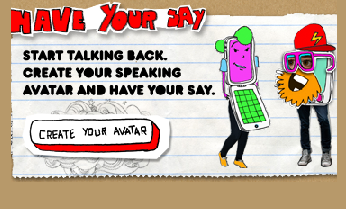Helping Teens Draw Their ‘Digital Line’

With digital communication a central part of teens’ lives, the Family Violence Prevention Fund (FVPF) is launching a new national public service advertising (PSA) campaign to help teens recognize digital dating abuse and take steps to prevent it. At a congressional briefing duringNational Teen Dating Violence Awareness and Prevention Week, the FVPF launched ThatsNotCool.com. It is designed to start a conversation among teens about how controlling behavior and harassment from a boyfriend or girlfriend, online or via cell phone, can turn into abuse.
The new campaign was created in partnership with the Advertising Council and the Department of Justice’s Office on Violence Against Women. At the briefing, experts from the FVPF, Break the Cycle and Youth Radio discussed programs and initiatives that can help stop youth dating violence, including the That’s Not Cool campaign.
ThatsNotCool.com
Created pro bono by the digital ad agency R/GA, That’s Not Cool is a multimedia campaign that includes an interactive web site, mobile component, television, radio, posters in schools and malls, and Web ads all designed to help teens recognize digital dating abuse and give them the platform to initiate conversations about it. The PSAs direct audiences to visit www.ThatsNotCool.com where teens can find tools to “draw their own digital line” and a forum to discuss this form of abuse and seek help.
“Our research confirms that teens often don’t know how to connect the dots and recognize when controlling behavior becomes abuse,” said FVPF President Esta Soler. “The That’s Not Cool campaign is designed to help start a conversation about textual harassment and digital abuse, give teens the tools to recognize and talk about it, and encourage them to define what is and isn’t okay.”
With the benefit of new technologies comes the risk of digital abuse, which can include unwanted, repeated calls or text messages, breaking into email or social networking accounts, or being pressured to send private or embarrassing pictures or videos. The Technology and Teen Dating Abuse Survey, conducted by Teen Research Unlimited for Liz Claiborne in 2007, found that one in three teens say they have been text messaged 10, 20 or 30 times an hour by a partner wanting to know where they are, what they’re doing, or who they’re with. One in four teens in a relationship have been called names, harassed or put down by a partner through cell phones and texting. More than half of teen girls (51 percent) say pressure from a guy is a reason girls send sexy messages or images, and 18 percent of teen boys say pressure from a girl is a reason (Sex and Tech Survey, conducted by the National Campaign to Prevent Teen and Unplanned Pregnancy, 2008).
“We are very proud to join with the Family Violence Prevention Fund and R/GA on this critical campaign to help prevent teen dating abuse,” said Ad Council President and CEO Peggy Conlon. “While teens often recognize the signs of physical abuse, digital abuse has many gray areas and its dangers are often minimized. This campaign will engage teens and give them the tools to draw the connection between the digital infractions they are experiencing and abuse.”
At the Briefing
Congressman Ted Poe (R-TX) told the audience, “I appreciate the fact that you’re here trying to solve this problem.” Poe spoke eloquently about an influential figure in his life, his grandmother. “She always said you never hurt someone who you love, and we’ve got to communicate that message to teenagers.”
A representative from Congressman John Lewis’ (D-GA) office said the Congressman redoubled his commitment to preventing violence after a Congressional Fellow working for the Congressional Black Caucus was murdered by a former boyfriend after she returned to college. Lewis has introduced the Teen Dating Violence Prevention Act of 2009 (H.R. 789), which would authorize the Department of Justice to: develop targeted grants that provide counseling to victims and abusers; help youth victims who are runaways, homeless, in foster care or are youth offenders; offer legal services; and more.
FVPF Director of Public Communications Brian O’Connor detailed the research behind That’s Not Cool, and Break the Cycle Director of Policy Programs Juley Fulcher discussed how best to reach students on campuses and help schools address dating violence. “We want to make public and private schools allies in the fight against teen dating violence,” she said, noting that Washington, D.C. public schools are the model for the Safe Schools Project, a new program that aims to develop a comprehensive response to teen dating violence. It will include written school policies, educator and staff training, violence prevention curricula for students, and an expanded network of community services for youth. More information on the Safe Schools Project is available at www.breakthecycle.org/technical-assistance-for-schools.html.
Youth Radio’s Director of Health Programs, Tuere Anderson, said her organization engages teens and young adults by helping them develop radio programs, including a public affairs program and community-organizing efforts, that address teen dating violence. “We want to give youth a voice and really hear what young people have to say,” she said. Youth Radio reaches 27 million listeners through local and national outlets including National Public Radio. For more information, visit www.youthradio.org/.
All the panelists asked Congress to fund the teen dating violence prevention programs in the Violence Against Women Act.
The Briefing was sponsored by Representatives Lewis and Steve Israel (D-NY). Both the House of Representatives and the Senate have passed resolutions declaring February 2 – 6, 2009 to be National Teen Dating Violence Awareness and Prevention Week. The resolutions encourage local, state and national organizations, governments and private industry to call attention to teen dating violence.
Visit www.thatsnotcool.com for more information on the new campaign. Its television and radio PSAs will be distributed to media outlets nationwide later this month.


